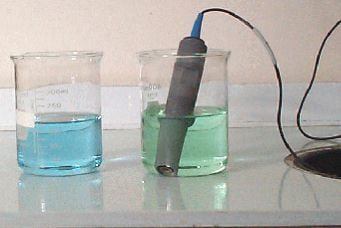Why is it important to discard the pH buffer solution after calibration?
There are typically 2 types of pH calibration methods, i.e. Single Point or 2 (Dual) Point.
Single point calibration
Single point calibration is usually done with the pH probe in the process water and the user calibrates the instrument to force the controller to read the same as the user’s independent test results. However, this method is not that accurate. It is better to perform a 2 point calibration.
 2(Dual) Point Calibration
2(Dual) Point Calibration
2(Dual) Point Calibration means the probe is calibrated at a zero point and a slope point. Both these points are achieved by inserting the pH probe in pH7 buffer first (zero point) and pH4 or 10 next (slope point).
pH Buffer solutions are required to calibrate a pH controller with a pH sensor (probe). The 3 most common pH buffer solutions are pH4, pH7 and pH10, and are usually a different colour to clearly distinguish between them. pH 4 is often red, pH7 green and pH10 blue. It is recommended to write the pH value on the cap of each bottle to prevent them getting mixed up.
As the reading needs to be spot on, it is best to discard the buffer you have decanted to take the measurement, and NEVER pour it back in the bottle as the buffer would then be contaminated.
pH buffer solutions should always be stored in a cool dry place and should be discarded responsibly if any remains after the expiry date, which is printed on the bottle.
When calibrating a pH controller, it is best to calibrate pH7 first and then to calibrate pH4 or pH10. Typically if you are operating in the acidic range (i.e. < pH7) then you will calibrate with pH7 and then pH4. Conversely if you are operating in the basic range (i.e. > pH7) then you will calibrate with pH7 and then pH10. However, the controller slope should perfectly linear, so either is fine. However, pH7 should be calibrated first.
When calibrating with different buffer solutions, be very careful not to contaminate the buffers. Hence, it is recommended to decant small amounts of buffers into separate cups and discard the contents of the cups when complete. NEVER pour decanted buffer solution back into the original bottle.
A recommended procedure for calibration is as follows (assuming calibrating with pH7 and then pH4):
- Rinse probe with distilled water (or pH7 buffer) and dry with paper towel.
- Decant a small amount of pH7 buffer into separate cup.
- Insert pH probe in cup, wait for reading to settle and calibrate zero point (i.e. pH7)
- Rinse probe with distilled water (or pH4 buffer) and dry with paper towel.
- Decant a small amount of pH4 buffer into a new separate cup.
- Insert pH probe in cup, wait for reading to settle and calibrate slope point (i.e. pH4)
If you do not have distilled or de-ionised water readily available for rinsing probes, you may use clean tap water.
